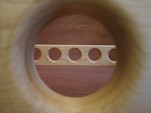Makes me think of those collapsible backpacking cups.
My first thought is that whatever style sweeper seal you use between the sections (garage door seal or RV slide out) will be interrupted by the exterior shelf std.'s. I'm assuming that the std.'s you referred to are the channel type with slots at regular intervals. Water will be able to go through the slots and travel through the channels bypassing the seals.
Otherwise I think it is a great idea... if you must have the ultimately short trailer over the road. But is it worth the effort to build it?
Engineering and design are always a compromise between design goals, cost and ability to manufacture (i.e. method... which is the same as cost).
Method and cost don't seem to be a problem on this scale, but the design goal of keeping water out may not be worth the design goal of maximizing towing efficiency. Internal space vs. aerodynamics. Is that worth the challenge of the complication of keeping it water tight?
Just $.02 worth of wax.
Foamie aerodynamics.
Moderator: eaglesdare
Re: Foamie aerodynamics.
KC
My Build: The Poet Creek Express Hybrid Foamie
Poet Creek Or Bust
Engineering the TLAR way - "That Looks About Right"
TnTTT ORIGINAL 200A LANTERN CLUB = "The 200A Gang"
Green Lantern Corpsmen
My Build: The Poet Creek Express Hybrid Foamie
Poet Creek Or Bust
Engineering the TLAR way - "That Looks About Right"
TnTTT ORIGINAL 200A LANTERN CLUB = "The 200A Gang"
Green Lantern Corpsmen
-

KCStudly - Donating Member
- Posts: 9613
- Images: 8169
- Joined: Mon Feb 06, 2012 10:18 pm
- Location: Southeastern CT, USA
Re: Foamie aerodynamics.
Here’s an idea , keep like it is , but make just the center section pop up , the front would be storage, the rear the galley .... Much easier to lift ... still streamline ...collapsed ... 

There’s no place like Foam !
-

GPW - Gold Donating Member
- Posts: 14912
- Images: 546
- Joined: Thu Feb 09, 2006 7:58 pm
- Location: New Orleans




